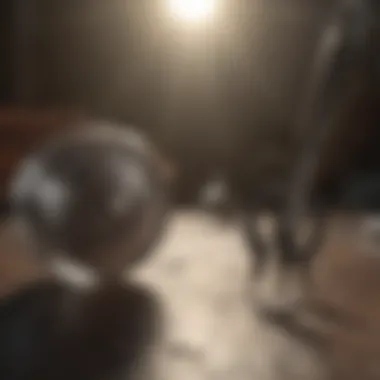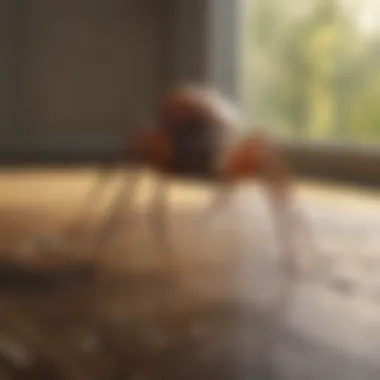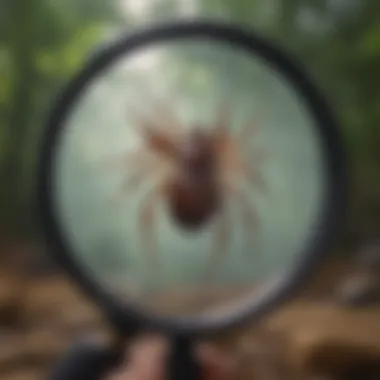Proven Techniques for Eliminating Ticks Around Your Home and Yard


Preventive Pest Control Strategies
When it comes to eliminating ticks around your house, starting with preventive pest control strategies is crucial. First and foremost, focus on safeguarding your house exterior. Seal any cracks or gaps around doors, windows, and foundations to prevent ticks from finding their way into your home. Clearing debris in your yard also helps as ticks thrive in cluttered areas. Implement measures to prevent pests from entering your property, such as installing screens on windows and doors. Another essential step is yard maintenance. Regularly mow your lawn, remove weeds, and trim bushes to create a tick-free environment. You can also use natural and safe pest repellents in your yard to keep ticks at bay. Indoors, emphasize cleanliness by adopting expert cleaning tips and techniques. Regular vacuuming, dusting, and decluttering are effective ways to maintain a pest-resistant indoor environment. Proper garbage disposal is equally important in pest control. Dispose of trash regularly, seal garbage bags tightly, and keep outdoor bins clean to deter pests. Explore innovative ways to safeguard your home, such as using ultrasonic pest repellents and planting tick-repelling plants in your garden.
Understanding Ticks
Ticks are a prevalent concern for households, presenting both nuisance and health risks. Understanding the behavior and characteristics of ticks is vital in effectively eliminating them from your surroundings. By delving into the specifics of tick anatomy, feeding habits, and preferred habitats, you can develop targeted strategies to combat infestations. Recognizing the common types of ticks and their distinct features enables a tailored approach to tick control.
Identifying Common Types of Ticks
Deer Ticks
Deer ticks, also known as black-legged ticks, are notorious for transmitting Lyme disease. These small arachnids prefer wooded areas and tall grasses, latching onto hosts for blood meals. Recognizable by their reddish-brown bodies and black legs, deer ticks pose a significant health concern due to their disease-carrying potential. Implementing measures to control deer tick populations is crucial in reducing the risk of tick-borne illnesses.
Brown Dog Ticks
Brown dog ticks primarily infest dogs but can also target humans. Identified by their reddish-brown color, these ticks are known carriers of various diseases, including Rocky Mountain spotted fever. Their ability to infest indoor environments makes them a persistent threat to household pets and occupants. Effective management of brown dog ticks involves both pet-specific interventions and household treatments.
Lone Star Ticks
Lone star ticks, named for the white spot present on females, are prominent in the southeastern United States. These aggressive parasites can transmit ehrlichiosis and tularemia to humans, prompting the need for proactive control measures. Recognizable by their reddish-brown bodies and white markings, lone star ticks require targeted eradication efforts to minimize human exposure and potential health risks.
Life Cycle of Ticks
Egg Stage
Ticks begin their life cycle as eggs, laid by adult females in secluded environments. The egg stage is crucial for tick proliferation, as it sets the foundation for future populations. Understanding the egg-laying preferences and survival requirements of ticks is essential in disrupting their reproductive cycle and population growth.
Larva Stage
After hatching from eggs, ticks enter the larval stage, characterized by six legs and minimal size. Larvae seek hosts for their first blood meal, often preying on small animals and birds. Targeting larval ticks through environmental modifications and host control strategies is key to preventing their development into nymphs and adults.
Nymph Stage


Nymph ticks possess eight legs and are more voracious feeders than larvae. These immature ticks often harbor diseases from previous hosts and can transmit infections to humans and animals. Identifying and removing nymph ticks at early stages of infestation is critical in reducing disease transmission risks.
Adult Stage
At the adult stage, ticks have fully developed into their reproductive phase. Engorged female ticks can lay hundreds to thousands of eggs, perpetuating infestation cycles. Adult ticks are proficient at finding hosts and can transmit diseases efficiently. Implementing effective control measures at the adult stage is paramount in preventing large-scale infestations and safeguarding against potential health threats.
Preventative Measures
Tick prevention is a critical aspect of maintaining a tick-free environment around your house. By implementing preventative measures, you can significantly reduce the likelihood of tick infestations, minimizing potential health risks for your family and pets. These strategies not only help control tick populations but also create a safer living space overall.
Landscaping Techniques
Regular Grass Mowing
Regular grass mowing plays a vital role in tick prevention by eliminating tall grass where ticks often thrive. Keeping your lawn well-maintained reduces the exposure of your family and pets to ticks, as shorter grass makes it harder for these parasites to hide and latch on. By adhering to a consistent mowing schedule, you can effectively limit tick habitats and enhance the visual appeal of your outdoor spaces.
Removing Leaf Litter
Removing leaf litter is a key preventive measure against ticks, as they tend to harbor in damp and debris-filled areas. Clearing up fallen leaves and organic debris in your yard not only improves the aesthetic value of your landscape but also minimizes potential tick breeding grounds. By keeping your outdoor spaces clean and debris-free, you can reduce the risk of tick encounters for your household.
Creating a Dry Barrier
Creating a dry barrier around your property acts as a natural deterrent for ticks, which prefer humid environments. By utilizing methods such as installing gravel or wood chip borders, you can create a dry zone that ticks are less likely to cross. This simple yet effective technique helps in limiting tick access to your living spaces and emphasizes the importance of environmental modifications in tick control efforts.
Pet Care Tips
Regularly Grooming Pets
Regularly grooming your pets is essential in tick prevention, as it allows you to inspect and detect any ticks or unusual bumps on their skin promptly. Grooming not only maintains the cleanliness of your pets but also enables you to monitor their overall health closely. By making grooming a consistent practice, you can reduce the likelihood of tick infestations and ensure the well-being of your furry companions.
Using Tick Prevention Medications
Utilizing tick prevention medications for your pets is a proactive approach to safeguarding them from tick-borne diseases. These medications come in various forms such as spot-on treatments or oral pills, providing different levels of protection. By consulting your veterinarian and following their recommendations on tick prevention products, you can effectively shield your pets from potential health threats posed by ticks.
Checking Pets Daily


Regularly checking your pets for ticks on a daily basis is a fundamental aspect of pet care. This routine inspection allows you to promptly remove any ticks found on your pets, reducing the risk of tick bites and associated diseases. By incorporating daily tick checks into your pet care regimen, you demonstrate a proactive stance towards protecting your pets from tick-related health issues.
Housekeeping Practices
Vacuuming Regularly
Regular vacuuming is a crucial housekeeping practice in tick prevention, especially in indoor areas where ticks may be present. Vacuuming not only removes dirt and debris but also helps eliminate ticks and their eggs that could be hiding in carpets, rugs, or furniture. By vacuuming regularly, you can maintain a clean indoor environment and minimize the chances of tick infestations within your living spaces.
Washing Bedding in Hot Water
Washing bedding in hot water is a simple yet effective strategy to kill any ticks that may have latched onto fabrics. High temperatures during washing help destroy ticks and their eggs, ensuring that your bedding is free from these parasites. By incorporating hot water washing into your laundry routine, you can enhance the cleanliness and hygiene of your living areas, reducing the risk of tick exposure.
Decluttering to Reduce Hiding Places
Decluttering your living spaces plays a significant role in tick prevention by minimizing potential hiding spots for these parasites. Removing unnecessary items and reducing clutter not only improves the overall tidiness of your home but also limits the places where ticks can thrive. By decluttering regularly, you create a less hospitable environment for ticks, contributing to your comprehensive tick control efforts.
Natural Remedies
In the quest to eliminate ticks around your house effectively, natural remedies play a crucial role. These remedies offer a safe and non-toxic alternative to chemical treatments, making them a popular choice among many homeowners. Natural remedies not only target ticks but also minimize harm to the environment and your family's health. By incorporating natural remedies into your tick control strategy, you can achieve a balanced approach that is both effective and eco-friendly.
Essential Oils
Lavender Oil
Lavender oil, derived from the lavender plant, is known for its pleasant fragrance and various therapeutic properties. In the context of tick control, lavender oil acts as a natural repellent, deterring ticks from infesting your living spaces. Its soothing aroma is a bonus, creating a calming atmosphere while warding off these unwanted pests. One key characteristic of lavender oil is its versatility - you can use it directly on skin, clothing, or diffusers to repel ticks effectively. However, it is essential to note that while lavender oil is generally considered safe for humans, it may cause adverse reactions in pets, so caution is advised when using it around animals.
Citronella Oil
Citronella oil, originating from the lemongrass plant, is renowned for its strong insect-repelling properties. When applied strategically, citronella oil acts as a potent barrier against ticks, keeping them at bay from your home and yard. The key characteristic of citronella oil lies in its effectiveness in repelling not only ticks but also other biting insects, making it a versatile solution for comprehensive pest control. However, keep in mind that citronella oil may require more frequent reapplication compared to chemical pesticides, requiring diligence in maintaining its barrier effect.
Eucalyptus Oil
Eucalyptus oil, extracted from the leaves of eucalyptus trees, is a powerful natural insect repellent with proven efficacy against ticks. Its strong scent acts as a deterrent, disrupting the sensory receptors of ticks and preventing them from latching onto hosts. One unique feature of eucalyptus oil is its ability to not only repel ticks but also kill them upon contact, offering a two-pronged approach to tick control. However, while eucalyptus oil is highly effective, it is crucial to dilute it properly before use to prevent skin irritation or adverse reactions in both humans and pets.


Diatomaceous Earth
Application Techniques
When it comes to utilizing diatomaceous earth as a natural remedy for tick control, proper application techniques are key to its success. Diatomaceous earth works by dehydrating ticks and other pests upon contact, making it an effective yet safe method for tackling infestations. The key characteristic of its application lies in thorough coverage - ensure you apply a fine layer of diatomaceous earth in areas frequented by ticks, such as entry points, baseboards, and pet bedding. Its unique feature of physical rather than chemical action sets diatomaceous earth apart, offering a non-toxic alternative that poses minimal risk to your family's health.
Effectiveness and Safety
In terms of effectiveness and safety, diatomaceous earth ranks high as a natural tick control solution. Not only does it target ticks at all life stages, but it also remains effective in dry environments, making it a versatile option for various climates. Its key characteristic of being pet and child-safe enhances its appeal, as you can use it indoors without worrying about adverse effects on your loved ones. However, while diatomaceous earth is generally considered safe, it is essential to use food-grade quality for controlling ticks to avoid any potential risks associated with inhalation or skin contact.
Professional Pest Control
When it comes to eliminating ticks around your house, professional pest control plays a crucial role in ensuring a thorough and effective approach. Professional pest control services offer expertise and specialized treatments that can target ticks at all stages of their life cycle. By enlisting the help of professionals, you can tackle severe infestations, address repeated tick bites, and avoid the pitfalls of ineffective DIY methods. Moreover, professional pest control services utilize advanced techniques and environmentally-friendly products to provide long-term solutions for keeping your home tick-free.
When to Seek Professional Help
Severe Infestation
Dealing with a severe tick infestation is a challenging task that requires immediate attention to prevent further spread and potential health risks. A severe infestation occurs when a large number of ticks have infiltrated your living spaces, posing a significant threat to you, your family, and pets. Professional pest control experts are trained to handle such critical situations by implementing targeted treatments that effectively eliminate ticks and their eggs. While addressing a severe infestation may require multiple treatments, the expertise of professionals ensures a comprehensive approach that restores your home to a safe and pest-free environment.
Repeated Tick Bites
Repeated tick bites signal a recurring problem that needs to be addressed promptly to prevent the risk of tick-borne illnesses. When you or your pets experience repeated encounters with ticks, it indicates an underlying issue that may stem from the presence of ticks in your surroundings. Professional pest control can identify the root cause of these repeated bites and implement measures to eradicate ticks and prevent future infestations. By seeking professional help, you can safeguard your family and pets from the adverse effects of tick bites and enjoy a peace of mind knowing that your living spaces are secure.
Ineffective DIY Methods
While DIY methods may offer temporary relief from ticks, they are often ineffective in providing long-term solutions to tick infestations. Ineffective DIY methods may include using over-the-counter sprays or homemade remedies that only target adult ticks, leaving behind eggs and nymphs that can lead to a resurgence of the infestation. Professional pest control services, on the other hand, employ systematic approaches and professional-grade treatments that cover all stages of the tick life cycle. By avoiding ineffective DIY methods and opting for professional assistance, you can eliminate ticks comprehensively and prevent their return.
Choosing a Pest Control Service
Licensed and Insured Companies
Selecting a licensed and insured pest control company is essential to ensure that you receive reliable and professional services for tick elimination. Licensed companies adhere to industry standards and regulations, demonstrating their competency and commitment to quality pest control practices. Additionally, insured companies provide liability coverage, protecting you from any unexpected damages that may occur during the treatment process. By choosing a licensed and insured pest control company, you can have confidence in the expertise and accountability of the service provider, promoting a successful outcome in eliminating ticks from your home.
Customer Reviews and Recommendations
Considering customer reviews and recommendations is a valuable aspect of selecting a pest control service that aligns with your needs and expectations. Customer feedback offers insights into the experiences of previous clients, giving you an idea of the service quality, reliability, and effectiveness of the pest control company. Positive reviews and recommendations indicate a reputable and dependable service provider that delivers results in eliminating ticks and maintaining a pest-free environment. By evaluating customer feedback, you can make an informed decision in choosing a pest control service that meets your requirements and ensures satisfactory outcomes.
Integrated Pest Management Approach
Opting for an integrated pest management (IPM) approach in pest control offers a comprehensive and sustainable solution for addressing tick infestations. IPM focuses on preventive measures, biological controls, and targeted treatments to manage pests effectively while minimizing environmental impact. By incorporating IPM strategies, pest control services can customize treatment plans based on the specific pest infestation, ensuring efficient and eco-friendly solutions for eliminating ticks. The holistic nature of the IPM approach promotes long-term tick management and reduces the reliance on chemical pesticides, making it a preferred choice for maintaining a healthy and pest-free home environment.



